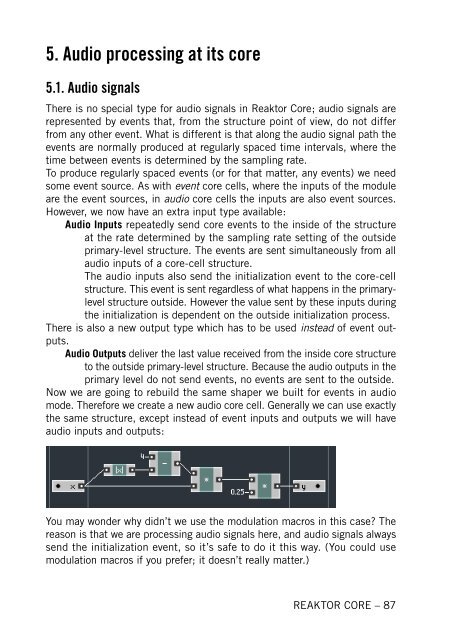1. First steps in Reaktor Core - Native Instruments
1. First steps in Reaktor Core - Native Instruments
1. First steps in Reaktor Core - Native Instruments
Create successful ePaper yourself
Turn your PDF publications into a flip-book with our unique Google optimized e-Paper software.
5. Audio process<strong>in</strong>g at its core<br />
5.<strong>1.</strong> Audio signals<br />
There is no special type for audio signals <strong>in</strong> <strong>Reaktor</strong> <strong>Core</strong>; audio signals are<br />
represented by events that, from the structure po<strong>in</strong>t of view, do not differ<br />
from any other event. What is different is that along the audio signal path the<br />
events are normally produced at regularly spaced time <strong>in</strong>tervals, where the<br />
time between events is determ<strong>in</strong>ed by the sampl<strong>in</strong>g rate.<br />
To produce regularly spaced events (or for that matter, any events) we need<br />
some event source. As with event core cells, where the <strong>in</strong>puts of the module<br />
are the event sources, <strong>in</strong> audio core cells the <strong>in</strong>puts are also event sources.<br />
However, we now have an extra <strong>in</strong>put type available:<br />
Audio Inputs repeatedly send core events to the <strong>in</strong>side of the structure<br />
at the rate determ<strong>in</strong>ed by the sampl<strong>in</strong>g rate sett<strong>in</strong>g of the outside<br />
primary-level structure. The events are sent simultaneously from all<br />
audio <strong>in</strong>puts of a core-cell structure.<br />
The audio <strong>in</strong>puts also send the <strong>in</strong>itialization event to the core-cell<br />
structure. This event is sent regardless of what happens <strong>in</strong> the primarylevel<br />
structure outside. However the value sent by these <strong>in</strong>puts dur<strong>in</strong>g<br />
the <strong>in</strong>itialization is dependent on the outside <strong>in</strong>itialization process.<br />
There is also a new output type which has to be used <strong>in</strong>stead of event outputs.<br />
Audio Outputs deliver the last value received from the <strong>in</strong>side core structure<br />
to the outside primary-level structure. Because the audio outputs <strong>in</strong> the<br />
primary level do not send events, no events are sent to the outside.<br />
Now we are go<strong>in</strong>g to rebuild the same shaper we built for events <strong>in</strong> audio<br />
mode. Therefore we create a new audio core cell. Generally we can use exactly<br />
the same structure, except <strong>in</strong>stead of event <strong>in</strong>puts and outputs we will have<br />
audio <strong>in</strong>puts and outputs:<br />
You may wonder why didn’t we use the modulation macros <strong>in</strong> this case? The<br />
reason is that we are process<strong>in</strong>g audio signals here, and audio signals always<br />
send the <strong>in</strong>itialization event, so it’s safe to do it this way. (You could use<br />
modulation macros if you prefer; it doesn’t really matter.)<br />
REAKTOR CORE – 87










